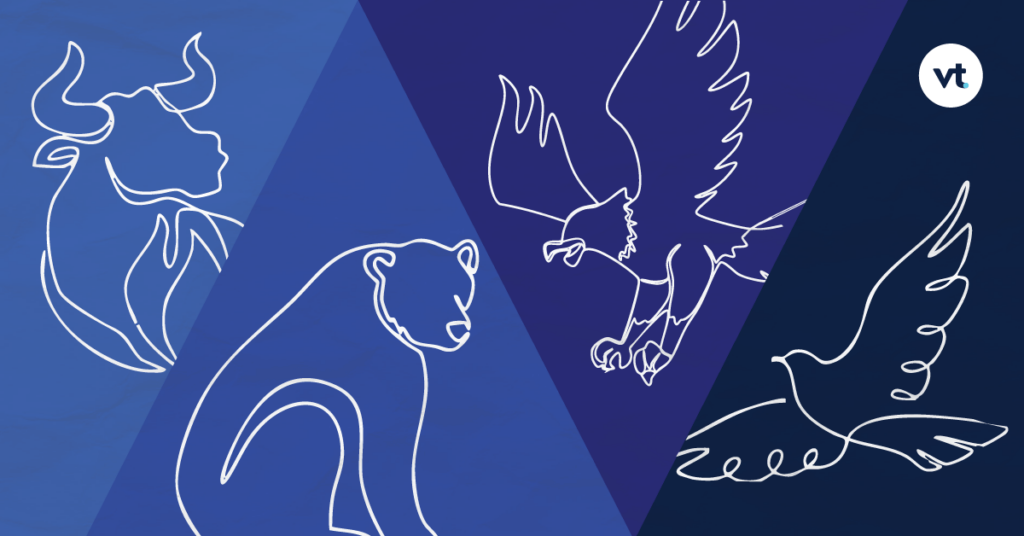The global financial markets are far removed from the animal kingdom. Yet, we can’t escape from the bulls, bears, hawks and doves whenever we discuss how market directions and monetary policies shape trillion-dollar decisions.

Some pivotal moments in the history of financial markets illustrate the spirit of these creatures, like these four examples:
1. Hawk – The Volcker Shock (1979 -1987)
A fine example of a hawkish monetary policy in action is the Volcker Shock. Under Chair Paul Volcker, the Federal Reserve raised interest rates to 20% to crush runaway inflation. This decision prioritised price stability over growth, even at the cost of a recession.
2. Doves – The Global Financial Crisis Response (2008)
Central banks worldwide slashed rates to near-zero and unleashed quantitative easing, epitomising dovish policy to revive collapsing markets.
3. Bulls – The Dot-Com Bubble (1995 – 2000)
Nasdaq’s 582% surge, driven by irrational exuberance for tech stocks, symbolised bullish sentiment at its peak.
4. Bears – The 2022 Market Meltdown
As inflation fears gripped investors, the S&P 500 plunged 25%, Bitcoin lost 65%, and bond markets suffered their worst year in history- a stark reminder of bearish despair.
Where Do Bulls, Bears, Hawks, and Doves Come From?
These terms are more than just metaphors.
They’re rooted in history, folklore, and the visceral behaviours of the creatures they represent. Let’s unpack their origins.
Bulls and Bears: Clashing Beasts of the Market
The bull and bear dichotomy dates back to 18th-century London. The terms likely originated from two sources:
Animal Combat: Bull-baiting, a brutal sport where dogs attacked bulls, was popular in Elizabethan England. Spectators likened market rallies to a bull charging upward (thrusting its horns) and downturns to a bear swiping downward (as if clawing prey).
Bearskin Jobbers: Early stock traders who sold shares they didn’t yet own (short-selling) were called ‘bearskin jobbers’, referencing the proverb ‘don’t sell the bear’s skin before you’ve caught the bear.’ Bulls emerged as their optimistic counterparts, buying aggressively in anticipation of rising prices.
Hawks and Doves: Political Birds Take Flight
The avian metaphors for monetary policy emerged from 20th-century US politics:
Hawks: In the 1960s, the term was borrowed from Cold War debates, where ‘war hawks’ advocated aggressive military action. Economists repurposed it to describe policymakers prioritising inflation control over growth. Hawks favour higher interest rates to ‘prey’ on inflation, even if it risks economic pain, akin to Paul Volcker’s 1980s crusade.
Doves: Conversely, doves entered the lexicon during the Vietnam War, describing politicians favouring diplomacy over conflict. Central bankers dubbed ‘doves’ focus on nurturing growth and employment, often keeping rates low despite inflation risks.
The terms gained traction in the 1970s as central banking shifted toward transparency. Fed meeting minutes from 1976 first used ‘hawkish’ to describe anti-inflation stances, while ‘dovish’ appeared in media by the 1980s.
Why Do These Metaphors Endure?
These terms persist because they viscerally capture abstract concepts:
Bulls and bears evoke primal forces of greed and fear.
Hawks and doves simplify wonky policy debates into a clash of instincts (attack vs. protect).
They also reflect humanity’s timeless habit of explaining the unknown through nature – a tradition as old as Wall Street.
Trade Your Way, Regardless Of Which Creature Rules The Markets
It doesn’t matter if the bulls are thrusting their horns up or the bears are swiping down with their paws. Or if the hawks are soaring higher than the doves.
With the right strategy and market understanding, anyone can take advantage of the market condition to generate worthwhile returns.
Open a live account with VT Markets today to start trading.







